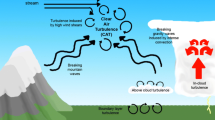Abstract
Acoustic reverberation signals generated by an experimental explosive source are analyzed by nonlinear dynamical methods. Three characteristic parameters, i.e., the correlation dimension, the largest Lyapunov exponent, and the Kolmogorov entropy, are estimated in the reconstructed phase space. The results indicate that the reverberation signals are nonlinear. The Volterra adaptive prediction method is introduced to model the oceanic reverberation signals. The reverberation time series can be predicted in short term with small prediction errors. A preliminary conclusion can be reached that the nonlinear low-dimensional dynamic system model is more suitable for modeling oceanic reverberation than the classical random AR model.
Similar content being viewed by others
References
Carmillet, V., P. O. Amblard, and G. Jourdain, 1999. Detection of phase-or frequency-modulated signals in reverberation noise, J. Acoust. Soc. Am., 105(6): 3375–3389.
Cai, Z., 2001. The study of underwater reverberation modeling and processing based on dynamical system. Ph.D. Dissertation. Harbin Engineering University, 18–76 (in Chinese with English abstract).
Cao, L. Y., 1993. Practical methods for determining the minimum embedding dimension of a scalar time series. Physica D, 110: 43–50.
Frison, T. W., H. D. I. Abarbanel, J. Cembrola, and B. Neales, 1996. Chaos in Ocean Ambient ‘Noise’. J. Acoust. Soc. Am., 99(3): 1527–1539.
Gall, J. L., 1984. Sonar detection in Weibull bottom reverberation. ICASSP, 1293–1296.
Grassberger, P., and I. Procaccia, 1983a. Measuring the strangeness of strange attractors. Physica D, 9: 189–201.
Grassberger, P., and I. Procaccia, 1983b. Estimation of the Kolmogorov entropy from a chaotic signal. Phys. Rev. A, 28(4): 2591–2593.
Kay, S., and J. Salisbury, 1990. Improved active sonar detection using autoregressive prewhiteners. J. Acoust. Soc. Am., 87(4): 1603–1611.
Kennel, M.B., R. Brown, and H. D. I. Abarbanel, 1992. Determine embedding dimension for phase-space reconstruction using a geometrical construction, Phys. Rev. A, 45: 3403–3411.
Liang, J., and J. Lu, 2000. Obtaining and utilizing the low dimensional dynamical component from underwater acoustic target radiated noise. Acta Acustica, 25(5): 416–420 (in Chinese with English abstract).
Lü, J. H., J. A. Lu, and S. H. Chen, 2002. Chaotic Time Series Analysis and Its Applications. Wuhan University Press, Wuhan, 60–66 (in Chinese with English abstract).
Rosenstein, M. T., J. J. Collins, and C. J. De Luca, 1993. A practical method for calculating largest Lyapunov exponents from small data sets. Physica D, 65: 117–134.
Olshevskii, V. V., 1977. Statistical Characteristics of Sea Reverberation. Luo, Y. J., trans., Science Press, Beijing, 67–99 (in Chinese).
Solo, V., and X. Kong, 1995. Adaptive Signal Processing Algorithms: Stability and Performance. 1st ed., Prentice Hall, New Jersey, 377pp.
Takens, F., 1981. Detecting strange attractors in turbulence. In: Dynamical Systems and Turbulence, Vol.898. Rand, D. A. and Young, L. S., eds., Springer-Verlag, Berlin, 366–381.
Wiercigroch, M., M. Badiey, J. Simmens, and A. H.-D. Cheng, 1999. Nonlinear Dynamics of Underwater Acoustics, J. Sound Vib., 220(5): 660–675.
Zhang, J. S., and X. C. Xiao, 2000. Predicting low-dimensional chaotic time series using Volterra adaptive filters. Acta Phys. Sin., 49(3): 403–408 (in Chinese with English abstract).
Author information
Authors and Affiliations
Corresponding author
Rights and permissions
About this article
Cite this article
Ren, X., Wang, N. & Xu, H. A study of oceanic reverberation modeling based on a nonlinear low-dimensional dynamic system. J. Ocean Univ. China 7, 228–232 (2008). https://doi.org/10.1007/s11802-008-0228-5
Received:
Accepted:
Published:
Issue Date:
DOI: https://doi.org/10.1007/s11802-008-0228-5




